Top 9 Business Intelligence Tools to Use in 2026
Table of contents
Vast amounts of data are generated every day. Approximately 90% of the world’s data was produced within the last two years! The data is precious (more than ever). It’s the new oil! If you take your business seriously, you should use a business intelligence tool that analyzes data to provide findings. Let’s check the best of them!
Business intelligence (BI) tools are software that collect, process, analyze, visualize, and report current and historical data! Shortly speaking, they transform a lot of raw data into east-to-understand dashboards, graphs, charts, maps, and reports so you can discover valuable insights. Thanks to BI, you can identify new markets for campaigns, learn how to develop your product, adjust your strategies, see the effectiveness of your activities, and much more!
Keep reading to discover the top 9 BI tools to use this year!
Top Business Intelligence Tools:
01 Brand24
Brand24 is both an AI-powered media monitoring software and one of the top BI tools, particularly for marketing.
In real-time, it tracks media mentions of everything (hashtags, keywords, companies, brands, product names, campaigns).
Brand24 is extremely powerful when you need social media data analysis!
It provides advanced analytics from the most important platforms:
- TikTok
- YouTube
- X (Twitter)
- Telegram
- Quora
- Twitch
It also analyzes data from other online sources like news sites, blogs, forums, review sites, newsletters, and podcasts.
Try the best BI tool!
Thanks to Brand24, you can see how effective your marketing strategies are!
When you create a new project, it will automatically start collecting media mentions containing the keyword.
However, this does not mean that mentions will appear in the dashboard only from the day the project was set up.
Here’s what the project looks like:
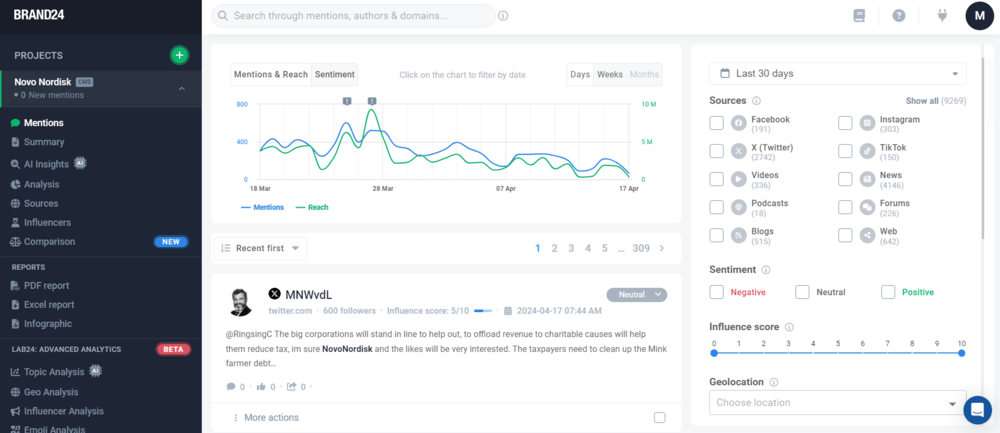
Brand24 tracks many key metrics, such as:
- The volume of mentions and reach
- Sentiment Analysis
- Share of Voice
- Online Presence Score
- Online Reputation Score
- Influencer Score
- AVE
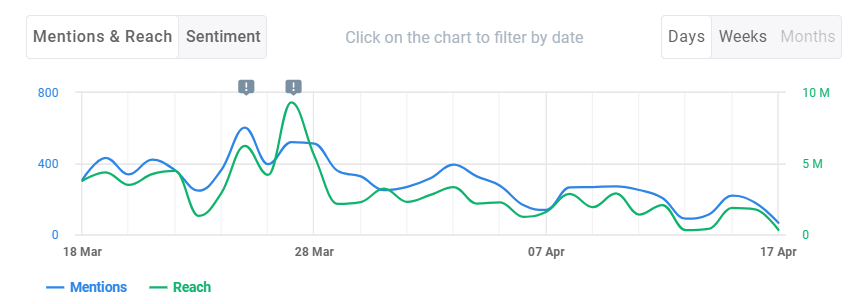
Brand24 not only counts the mentions. It also determines their emotional tone (positive, negative, or neutral).
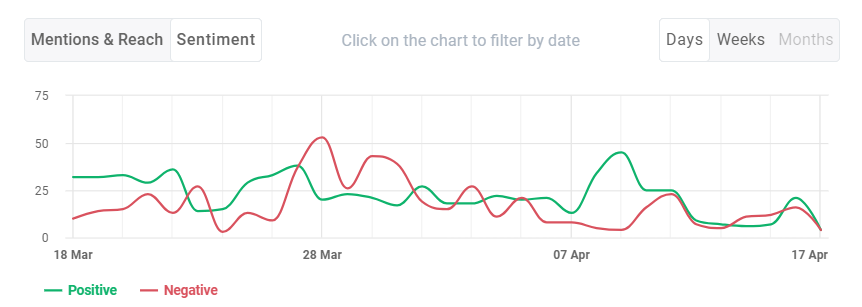
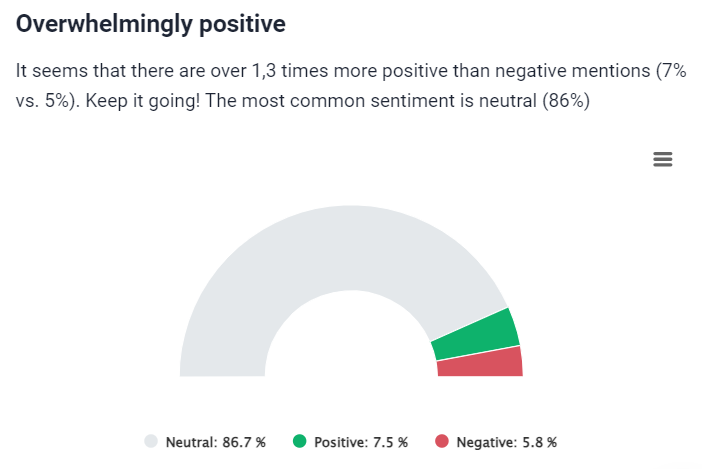
You can filter mentions by data sources, sentiment, geolocation, and more!
It helps a lot! For example, you want access to only negative mentions to respond to them. This action prevents a potential brand reputation crisis.
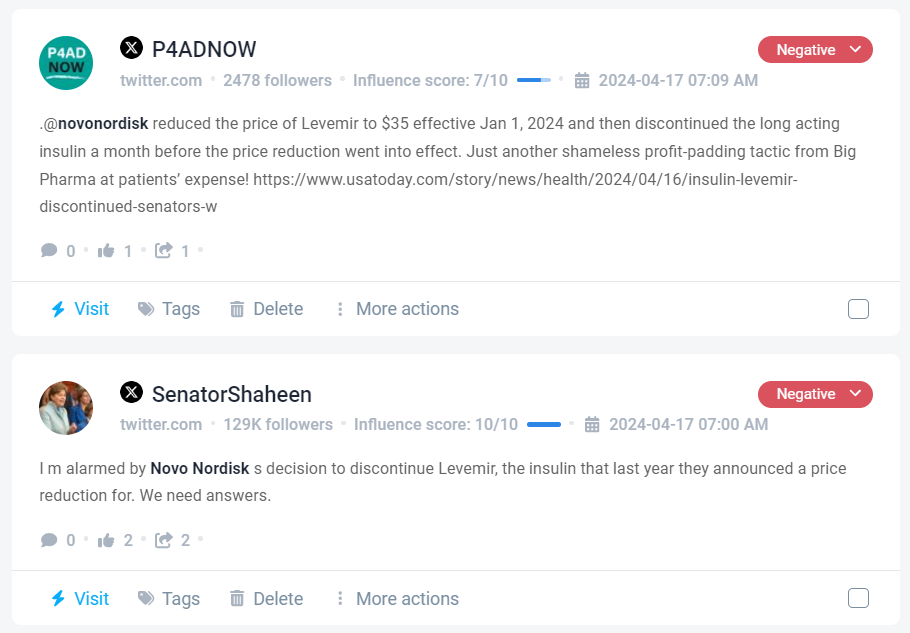
AI features cannot be forgotten when talking about this BI software.
One of these features is the Anomaly Detector.
Imagine that your company suddenly got a buzz on the Internet.
Instead of investigating what caused this rapid increase in mentions, the Anomaly Detector explains it to you!
Just click on the exclamation point above the peak.
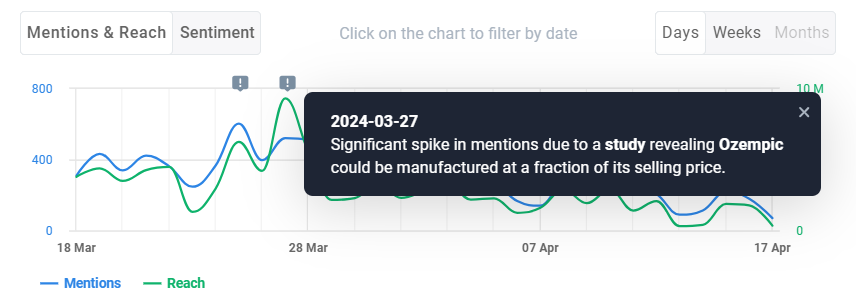
Another powerful feature is AI Insights.
You don’t have to manually analyze data to discover insights. Brand24 does it for you!
AI Insights provides you with ready-to-use recommendations. They can reduce your uncertainty in decision-making processes.
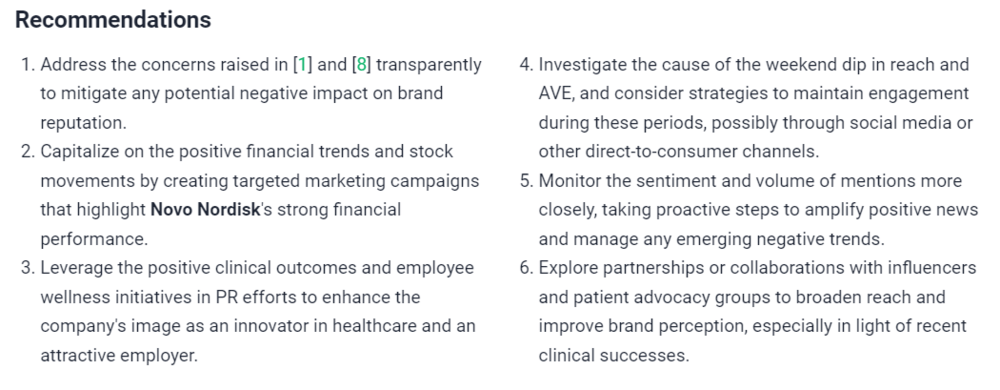
Sometimes, it’s so hard to discover data trends by yourself. It’s easy to miss something.
AI Insights identifies patterns and correlations in your datasets automatically!
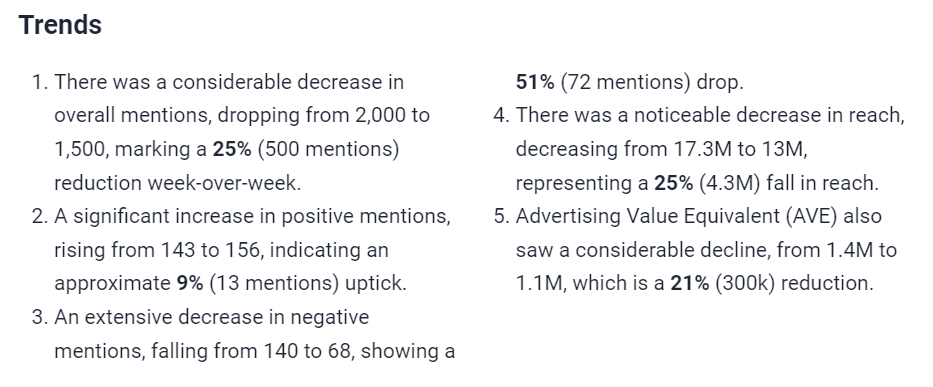
Different reports are also available in Brand24:
- E-mail reports
- PDF reports
- Excel reports
You don’t have to tire yourself anymore! Real-time data are turned into custom reports!
Moreover, Brand24 has a very user-friendly interface. Non-technical users master all the features of Brand24 effortlessly! It’s excellent news for marketing and customer relationship management people.
Besides, all data visualizations are top-notch… and dashboards are interactive!
Summing up, the critical features of Brand24:
- Advanced analytics
- AI-powered features: Sentiment Analysis, Emotion Analysis, Topic Analysis, AI Insights, Metrics Analysis, Intents Analysis
- Powerful AI Brand Assitant
- Interactive reports
- Analytics results available to business users
- Multiple data sources
- Customizable reports
- Real-time alerts
- High-quality data visualization
- Integration with external tools and products
- Advanced filters search
Try the best BI tool for marketing!
02 Power BI
Power BI is one of the most known business intelligence and data visualization tools. Microsoft developed it.
Thanks to this tool, you can track key business metrics – not just marketing ones but also others like sales, customer behavior, and financial.
Power BI uses the DAX (Data Analysis Expressions) formula language to perform total data and calculations. It’s not an easy ride, but it’s crazy powerful!
Power BI is Microsoft’s baby, so integration with other Microsoft products is excellent. For example, you can import data from Excel or export data visualization to PowerPoint.
It is worth using if you are used to Microsoft tools!
The most significant limitation of Microsoft Power BI is its complexity. Of course, if you know data analysis concepts and have experience with similar tools, it will be easier for you to learn Power BI.
But don’t kid yourself!
Do you want to use Microsoft Power BI in your company? You definitely need to get a real expert to create a dataset.
Key features:
- DAX
- Numerous possibilities for data visualization
- Drag-and-drop interface
- Data connectors and integrations for a wide range of data sources (i.e., MS Excel, MS SQL, BigQuery)
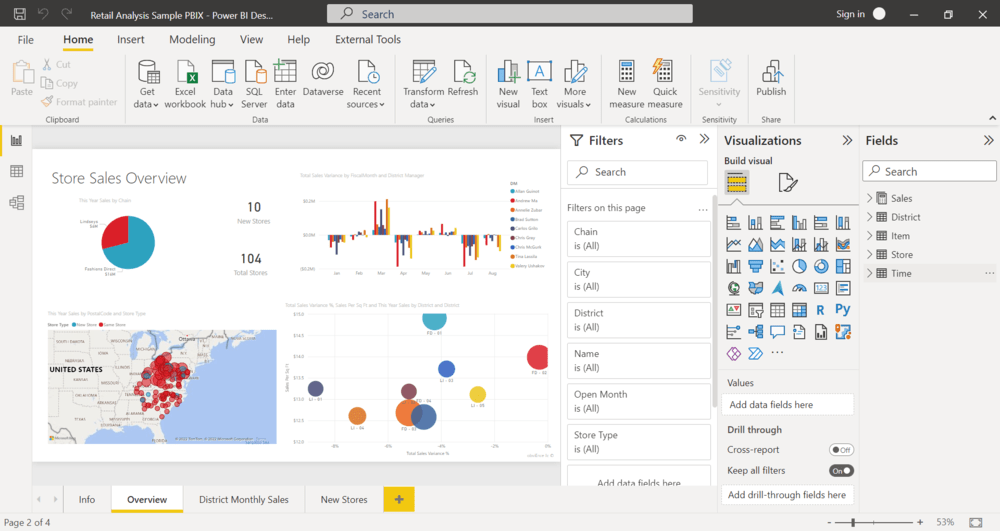
03 Tableau
Tableau is one of the leading business intelligence tools for data visualization.
It will help you to illustrate data in a meaningful way. You can create clear data visualizations like charts, graphs, maps, and scatter plots.
Tableau supports many data sources, such as:
- Microsoft Excel
- Microsoft SQL Server
- Google Analytics
- Salesforce
It provides unlimited possibilities for data analysis. You can easily combine data from different sources.
It’s a perfect solution for midsize and large organizations.
This tool has very good reviews among its users, but of course, it has drawbacks.
Tableau is considered easy to use and the perfect solution for business users. But only when the dataset is created (SQL knowledge is needed to do it)
Key features:
- Ad-hoc analysis
- Connection to any source
- Strong visualization possibilities
- Interactive and intuitive interface
- Easy dashboard sharing
- Mobile access
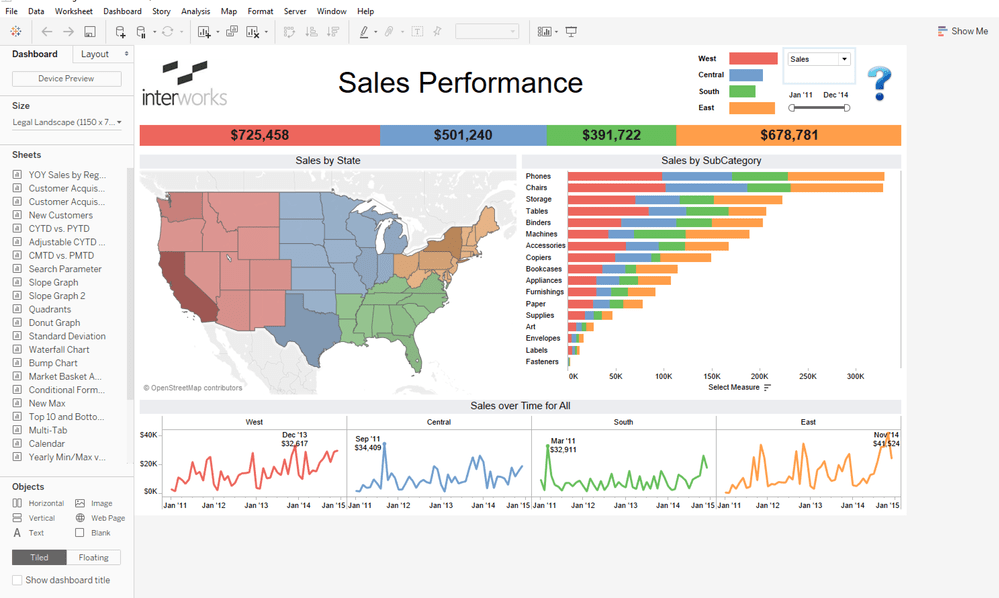
Try the best business intelligence software!
04 Metabase
Metabase is an open-source and self-service BI software.
It’s a free tool. So, if your budget doesn’t include implementing business intelligence software, check out Metabase.
The most remarkable thing about this tool is that it lets you ask questions or queries about your data without writing code or knowing SQL!
Who is this tool for? Metabase is for small and medium organizations and users without zero technical expertise.
The biggest disadvantage is the lack of features in the open-source version. But you can always buy the paid version, which can cost you even $500 monthly.
Key features:
- Ad-hoc data exploration
- Visual query builder
- Analysis in data warehouses
- Shared dashboards
- Easy installation and customization
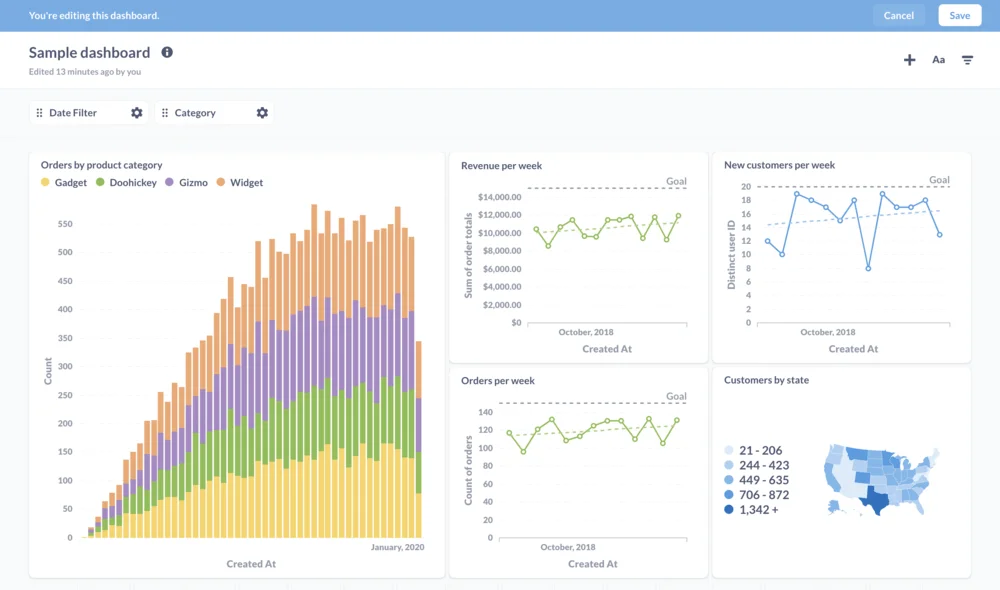
05 Looker Studio
Looker Studio is another free business intelligence tool. As with Metabase, a paid version with more features is available.
It’s a cloud-based platform developed by Google – formerly Google Data Studio (till October 2022). It integrates with Google products like Google Ads, Google Analytics, Google Search Console, and external data sources.
In Looker Studio, you can convert data into customizable informative reports and dashboards.
My favorite feature is sharing reports with particular people, by, for example, entering an email address. This makes it easy to share reports and work on the same report simultaneously.
Unfortunately, it can sometimes be laggy. Especially when working on large and complex datasets for a long time.
Key features:
- Powerful data modeling
- A wide variety of sources
- Integration with Google Analytics and other Google products
- Robust library of report templates
- Expansive connectors
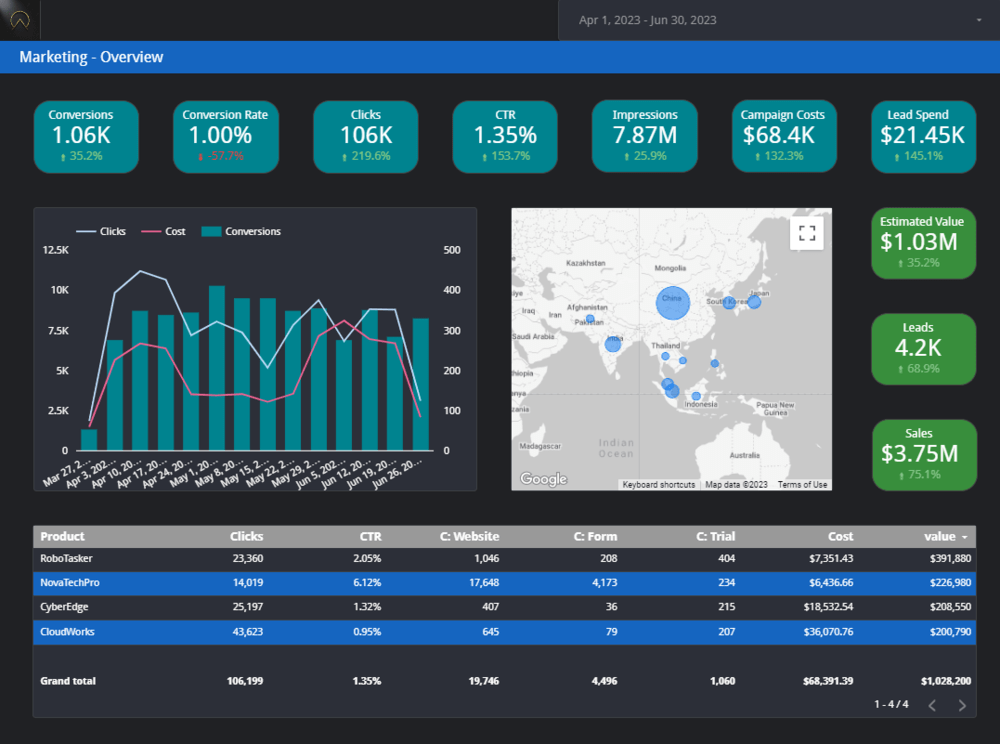
Start using the BI tool fo free!
06 Qlik Sense
Qlik Sense is one of the best business intelligence tools for conducting dynamic business analytics. It was launched in 2014 by Qlik.
It supports many sources across databases, cloud providers, data warehouses, and apps, such as:
- Azure
- Google Cloud
- Oracle
- SQL
It collects data from social media!
The tool is very efficient in processing large amounts of data. It seamlessly integrates data from multiple sources.
I suspect this is a pretty expensive solution… Qlik Sense does not provide pricing on its website.
If you don’t have such high requirements for the software, go for something cheaper.
Key features:
- Active data analytics
- Interactive data visualization
- Automated insight generation
- AI-assisted creation and data preparation
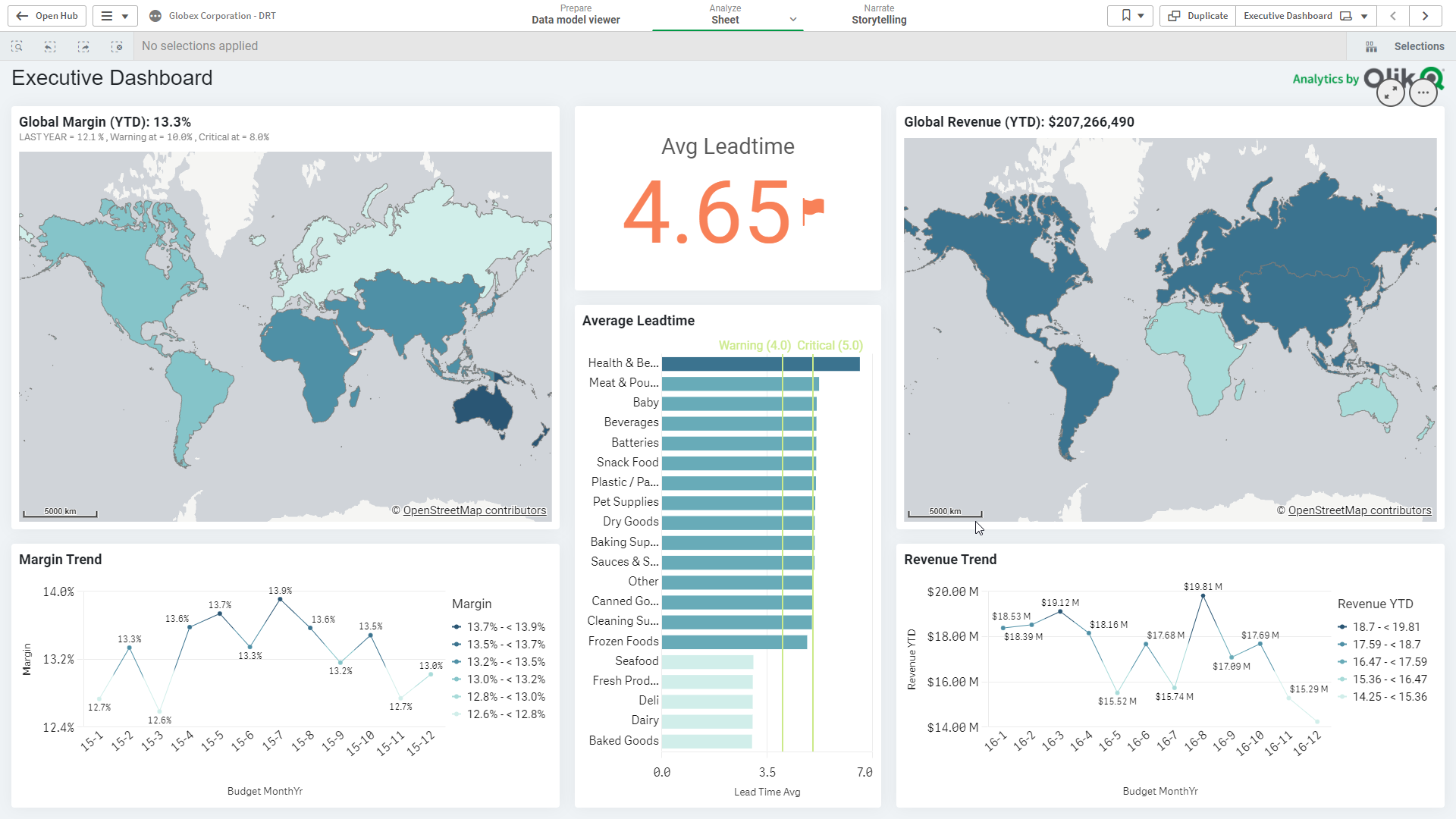
07 Sisense
Sisense is a business intelligence (BI) tool offering on-premises and cloud-based solutions.
This BI software has many features that allow the transformation of raw data into usable insights.
For example, thanks to advanced machine learning algorithms, Sisense predicts future trends and makes data-driven forecasts.
In comparison to competitors, Sisense processes data very fast!
However, this software’s visualization capabilities are worse than those of BI tools like Power BI or Tableau. Sisense should not be your first choice if you care about this aspect!
Key features:
- Ad-hoc analysis
- Integration of data from multiple sources
- Fast data transformation
- Wide range of visualization, including graphs, charts, and interactive dashboards
- Embedded analytics
- Machine-learning integration
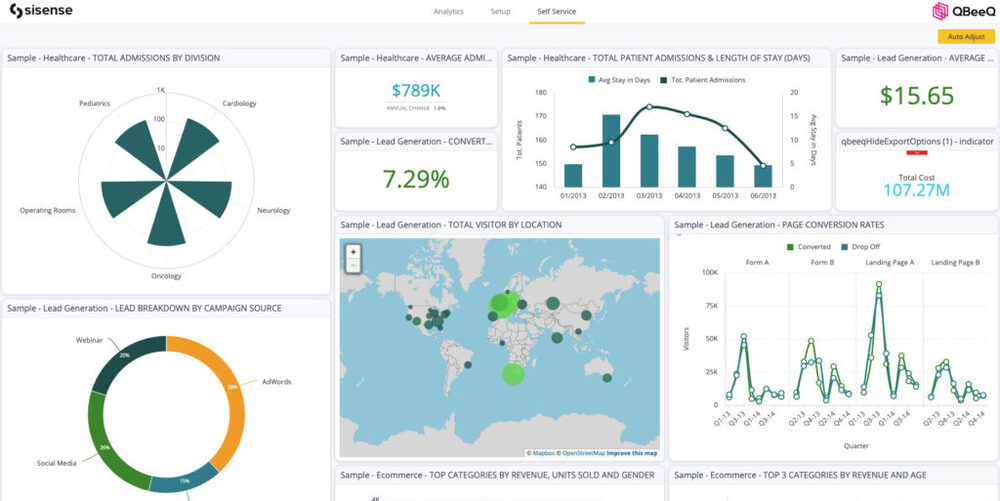
Analyze and report data with the BI tool!
08 Domo
Domo is a comprehensive BI platform that combines data integration, visualization, app creation, security, and governance!
Thanks to this platform’s features and tools, it is possible to collect, analyze, visualize, and share data from different sources.
Domo is the best for data management; it’s extremely easy and flexible!
Trust me, managing Domo is a piece of cake once the data is connected to the platform.
Although it has an intuitive interface, it gives the impression of being quite old. It may bother some users… maybe you, too. A design update would be more than welcome!
Key features:
- Easy-to-use visualizations and dashboards
- Automated and simple reports
- AI/ML insights
- Cloud infrastructure
- App creation tools
- More than 1,000 connectors
- Built-in data governance
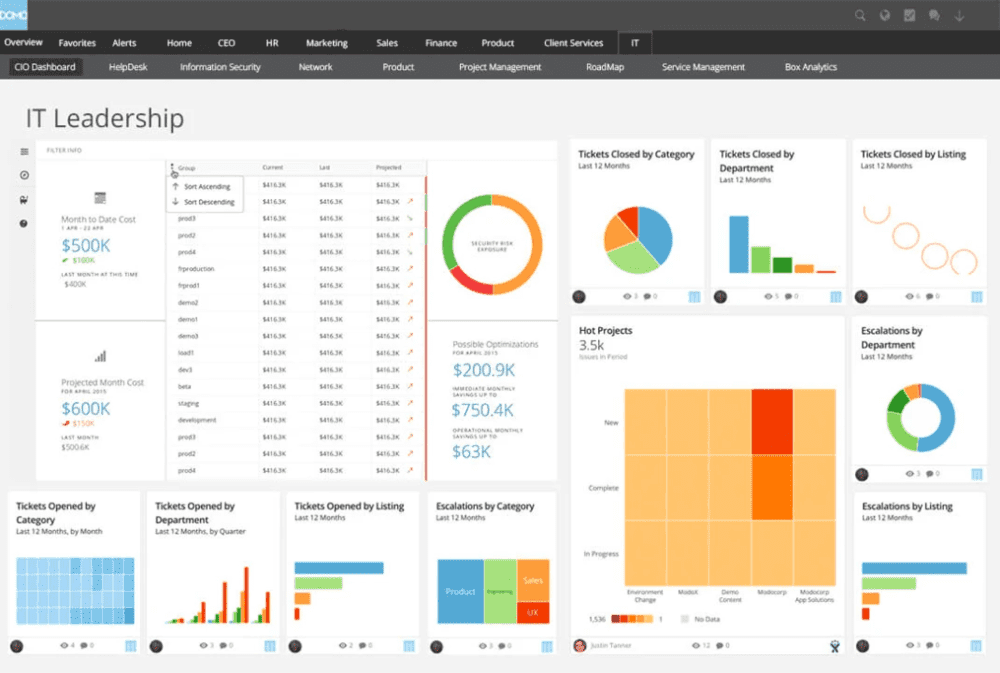
09 datapine
datapine is an all-in-one BI platform created to be easily accessible to non-technical users.
It’s a self-service BI. Everyone, regardless of data science knowledge, can:
- Integrate data sources
- Analyze data
- Create data visualizations
- Generate business insights
Moreover, datapine offers AI-powered data alerts. They let you know when something noteworthy happens in your collected data.
The biggest drawback of this product is that updates haven’t been made over the years. When other BI tools constantly develop, launch new features, and focus on AI technology, datapine does not move forward.
Key features:
- Real-time business data monitoring
- Fast and easy data connectors
- Drag and drop interface
- Effective reporting
- Flexible and highly customizable dashboards
- Over 50 dashboard templates
- Data alerts
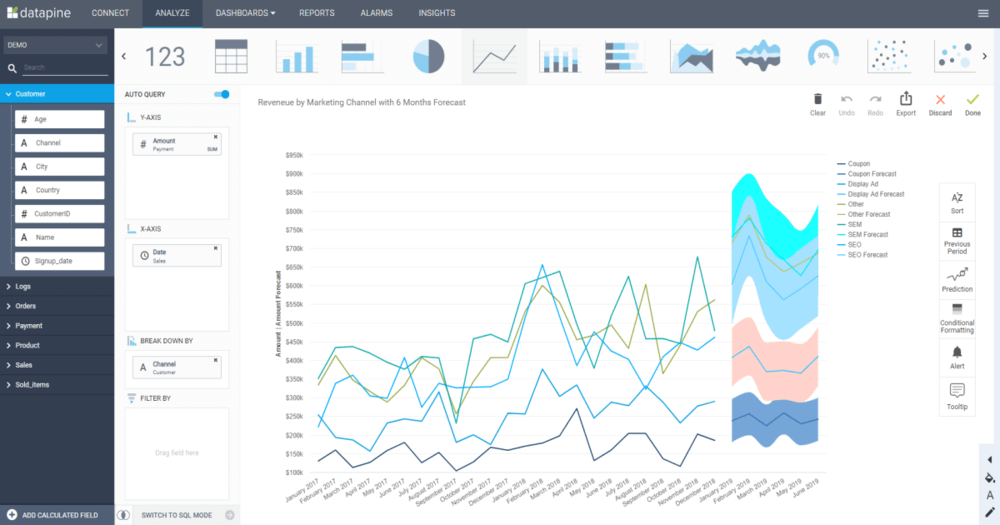
Try the best BI tool right now!
What are the most important features of great business intelligence software?
The key features of the best business intelligence tools are:
- Data integration capabilities: Every decent BI tool should be able to integrate data from different sources (databases, spreadsheets, cloud services, etc.). Integrating all the data provides a comprehensive view of your business, the best possible analysis, and, consequently, insights. Missing out some data may involve making a wrong business decision.
- Real-time analytics: To get the most out of data, you need to collect them in real-time and analyze them ASAP! Therefore, there is no option for the BI tool to collect and analyze data in a different way – only real-time matters.
- Historical analytics: Business intelligence would not exist without historical data. Data-driven decision-making needs not only current data but also past data. This is a guarantee of success!
- Different AI-powered features: Advanced BI tools must have AI-powered features. They help identify patterns, market trends, and anomalies you might not have noticed. Moreover, artificial intelligence provides predictive capabilities. The more AI features, the better for you!
- Data visualization: A wide range of data visualizations is essential. You should have different graphic format options, including graphs, charts, plots, and maps. They should be aesthetically pleasing and easy to read. The visualization readability affects the data’s understanding by you and others – unclear or too complicated can lead to misinterpretations.
- Interactive dashboards: Interactive dashboards have become very popular, and no wonder why. They allow users to dig into data! They provide real-time data updates, which gives them an advantage over PDF reports. This benefits dynamic business environments where data is produced like in a factory.
- Customization: The tool should have customized reports and dashboards. Customization allows you to tailor the BI tool so you can focus on crucial metrics for your company or key metrics during a given period.
- Scalability: The tool you choose should grow with your business. Your company grows, so do your needs. The tool must be scalable so that you can expand your capabilities at any time without changing the tool.
How to choose a business intelligence tool?
Choosing the right business intelligence tool is the key to success!
So here is the step-by-step guide on how to choose a BI tool that aligns with your business:
- Define your needs and goals: Do it by answering the most important questions “What kind of data do I want to analyze in the tool?”, “Who will use the tool?”, “What kind of analysis do I want to get?” and “What do I want to achieve using this tool?”.
- Check the features: After answering the questions, you already know what you expect from the tool. Now, check if the given tool has the required features and can provide you with the analysis you need.
- Consider the budget: Some BI tools can cost a lot. Be realistic! Don’t cheat yourself, and choose a tool for your pocket. Remember that the most expensive solution is not always necessarily the best.
- Think about the users: Deeply analyze who will be using it and their level of technical expertise. Some tools can be complex and complicated (to use some BI tools, firstly, you need to set up a database), and some are easy to use (like Brand24 – setting up a database is not required). The significant advantage of user-friendly software is that business users with no data science knowledge can use it without a problem. Consider whether implementing such an advanced tool and training existing employees or expanding the team with an expert is worth doing. Sometimes, the game is not worth a candle, so go for a simpler solution!
- Check the reviews and case studies: Reviews on marketplaces like G2 or Capterra are worth checking. You can rely on the reviews of people working in a similar position. What worked for them may also work for you. Also, find case studies of a company from your industry or similar use cases. Usually, they are presented on the tool’s website (Brand24 case studies).
- Compare the tools: You can compare the overall rating, price, and features of the tools you want to try. You can easily do it using G2 or Capterra. This will give you an idea of which option is the perfect match for you and which may be a good alternative.
- Try the tool: Always (if possible) try the tool before buying it. If it does not meet your expectations, you can try another one.
Following the above seven steps will reduce the risk of the BI tool being unsuitable for your company!
Try the best BI tool!
Conclusion
As you can see from this article, the market offers different business intelligence tools. Base your choice mostly on your needs, goals, and (of course) budget!
The wrong business intelligence software can make your work way more difficult instead of making it easier.
Do you need an intuitive tool that provides you with high-quality data visualization? Choose Tableau!
Do you want a free tool and, at the same time, very good and easy to use? Go for Metabase!
Are you a social media marketer who needs a tool with advanced analytics, reporting capabilities, and valuable insights from your brand’s social media? Try Brand24!
Final thoughts:
- Using BI tools in 2024 is a MUST – they translate collected data into actionable insights, significantly improving different business operations.
- BI tools can be used in various industries and company departments.
- Feel free to check different tools! Many of them offer a free trial; take advantage of this opportunity.
Click here to try Brand24 for free – the best business intelligence software to improve your marketing game!

